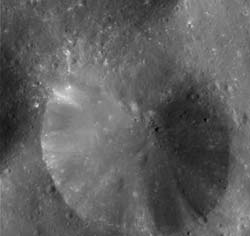Crater on Phoebe in close-up

Credits: NASA/JPL/Space Science Institute
This amazing high-resolution image of Phoebe’s pitted surface was taken very near the closest approach by the NASA/ESA/ASI Cassini-Huygens spacecraft.
It shows a crater with a diameter of 13 kilometres and a debris-covered floor. Part of another crater of similar size is visible at left, as is part of a larger crater at the top and many scattered smaller craters.
The radial streaks in the crater are due to downslope movements of loose fragments from impact ejecta (material thrown out by impacts). Also seen are boulders ranging from about 50 to 300 metres in diameter.
These ’building-sized’ rocks may have been excavated by large impacts, perhaps from some other region of Phoebe rather than the craters seen here. There is no visible evidence for layering of ice and regolith (or a hardened crust, or mantle) in this region, as on other parts of this moon.
Some of the relatively bright spots are from small impacts that excavated bright material from beneath the dark surface. Images like this provide information about impact and regolith processes on Phoebe.
The Cassini-Huygens mission is a co-operative project of NASA, ESA and the Italian Space Agency.
Media Contact
More Information:
http://www.esa.int/SPECIALS/Cassini-Huygens/SEMBZ33VQUD_0.htmlAll latest news from the category: Physics and Astronomy
This area deals with the fundamental laws and building blocks of nature and how they interact, the properties and the behavior of matter, and research into space and time and their structures.
innovations-report provides in-depth reports and articles on subjects such as astrophysics, laser technologies, nuclear, quantum, particle and solid-state physics, nanotechnologies, planetary research and findings (Mars, Venus) and developments related to the Hubble Telescope.
Newest articles

A universal framework for spatial biology
SpatialData is a freely accessible tool to unify and integrate data from different omics technologies accounting for spatial information, which can provide holistic insights into health and disease. Biological processes…

How complex biological processes arise
A $20 million grant from the U.S. National Science Foundation (NSF) will support the establishment and operation of the National Synthesis Center for Emergence in the Molecular and Cellular Sciences (NCEMS) at…

Airborne single-photon lidar system achieves high-resolution 3D imaging
Compact, low-power system opens doors for photon-efficient drone and satellite-based environmental monitoring and mapping. Researchers have developed a compact and lightweight single-photon airborne lidar system that can acquire high-resolution 3D…





















